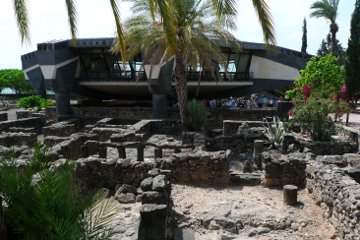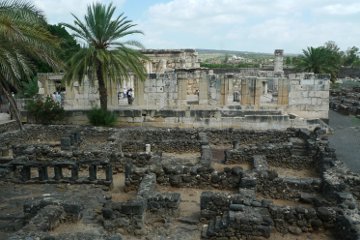The Synagogue at Capernaum
Capernaum, on the north-western shore of the Lake of Galilee, is one of the "must see" sites for any pilgrimage or tour of the Holy Land. Although the ruins are not the most spectacular in Palestine, the story of Jesus cannot be left out of Israel's history and Capernaum is intimately associated with Him.
The visitor parks his car or bus in the car park a couple of hundred yards from the entrance, then walks down a lane past the buildings of the Franciscan monastery on the right, to the gate where the monks prove that they are not other-worldly when it comes to charging admission prices! Indeed, this hunger for money goes to the point where the somewhat obnoxious young man in the ticket booth keeps an eye on tourists and pounces on them if their cameras are larger than he considers normal and demands a professional photographer's fee from them!

| |
| The ghastly modern church that disfigures the ruins of Capernaum. |
The reason for this squalid attitude is found as soon as you pass through the gate. Various people have conducted excavations at Capernaum, the most prominent of whom was Gaudenzio Orfali (1921-1926). Among the discoveries was the remains of a small octagonal building, beneath which was one particular 1st century AD house in a row of similar black basalt houses. It was not unreasonable for the excavators to suggest that the house may have been of particular significance to have a church built over it.
It was unreasonable to leap to the conclusion that it must be the house of Peter. For all we know, the octagonal church was built on the only empty site in town where the village drunkard's house had burned down! It would be just as reasonable to claim that the church was built to honour James or John or even the tax collector Matthew. The claim that the walls held graffiti including the name of Peter have been discounted by less biased scholars who fail to see anything other than random markings.
Nevertheless the good Franciscan brothers became convinced that this was the very house of Peter and one might smile indulgently and pass on had they not become equally convinced that they needed to mark the structure with a building of their own. I suspect they would have been just as happy to bury the ancient building beneath a massive basilica along the lines of the church in Nazareth, but someone obliged them to preserve the octagonal building.
The result is a hideous "flying saucer" on obtrusive concrete stilts which makes it look as if "Independence Day" has come to Capernaum and is about to send down a traction beam - or, considering the ruins of the octagonal building cowering beneath it, perhaps it already has sent down the beam!

| |
| The White Synagogue of Capernaum with the black basalt houses of the village in the foreground. |
The other large building on the site is a white limestone structure identified as a synagogue. When it was reconstructed by Fr Orfali many people thought that this was the synagogue where Jesus worshipped. Subsequent investigations, which turned up a hoard of 25,000 coins, have proved that this white building was constructed in the fourth or fifth centuries AD. There is a layer of large black stones beneath the white ones and it has been suggested that they represent the synagogue of Jesus' day, but I must admit that to my eyes they appear to be the foundations on which the white synagogue was constructed.
Whatever the final conclusion in the matter may be, the date of the white synagogue poses a curious problem. By the mid-fourth century AD the Roman empire had become Christian and a search was underway for sites and buildings that could be linked to the new religion. There was the octagonal church, of course, but it seems unlikely, to say that least, that the detested Jews would be allowed to positively dwarf it with a massive synagogue within spitting distance. In fact, there is no evidence for a Jewish population in Capernaum at this time, let alone one wealthy enough to build such a significant new synagogue.
Uri Zvi Ma'oz, an Israeli archaeologist who has made something of a specialism of ancient synagogues, has come up with a novel solution to the problem. He suggests that the synagogue has nothing to do with Jews! Instead he claims that it was built by the Byzantine Christians - possibly on the ruins of the old synagogue - as a pilgrim site.
Byzantine pilgrims would come to Capernaum expecting to see the synagogue where Jesus healed the sick and preached to the locals, where Jairus was leader, and where demons were cast out. The house of Peter (if that is what it was) was all very well, but where was the synagogue? Rather in the manner of Egyptian craftsmen filling the tourist demand for "genuine" Egyptian antiquities, the Byzantine authorities had no scruples about giving the pilgrims what they wanted.
Of course, they wanted to keep costs to a minimum and reused as many stones as possible, which has resulted in an incongruous mix of various styles and had the added advantage of giving the building a suitably antique look. To enhance the ancient look of the place, the builders never bothered to put a roof to their "synagogue" - a neat explanation for the fact that no roof tiles were found in the ruins. In this "Disney-land" synagogue, there were three large doors, far more than any synagogue would need but possibly required to enable tour groups to enter and exit with the minimum of fuss.
Needless to say, Ma'oz' explanation is not accepted by everyone, but it is certainly an ingenious solution to the puzzle of the synagogue without a congregation.





